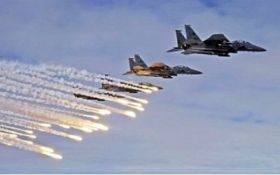US Journal shows cost of war against ISIS

Baghdad (IraqiNews.com) The US Wall Street Journal revealed fighting the war against the ISISin numbers.
The report shows that the numbers say a lot about the U.S.-led intervention in Syria.
Two figures illustrate U.S. strategy on the different, albeit intertwined, wars playing out in Syria: one focused on Islamic State and the other on the regime of President Bashar al-Assad. As of Dec. 30, the United States and a few allied air forces have launched more than 420 airstrikes since Sept. 1 against bands of Islamic State fighters in Kobani, a small town on the Turkish border. Kobani once had a population of 40,000.
The strikes are intended to help a local Kurdish militia hold on to its town, which has been largely depopulated and destroyed.
In contrast, the U.S.-led coalition has launched only 21 airstrikes on the outskirts of Aleppo, one of the world’s oldest cities and one of the largest in Syria. Aleppo has a population of more than 2 million. The strikes hit ISIS targets but have assiduously avoided targeting Mr. Assad’s forces, which control about half of Aleppo and are threatening to encircle the city to starve it-as they have done elsewhere in Syria.
The other part of Aleppo is held largely by U.S.-backed rebels. They are gradually losing the battle to keep the most strategic city outside the Syrian capital. But Washington and its allies do not want to get directly sucked into Syria’s civil war.
The numbers reflect the mounting costs of the U.S. intervention-and what’s to come. They suggest impact, and a time frame for yet another long war in the region. Washington has acknowledged that its new initiative will last at least three years, during which it hopes to train 5,000 fighters each year. The goal is not to defeat the Assad regime militarily but to pressure it to negotiate with the rebels.
The Pentagon said this month that costs of the first four months of Operation Inherent Resolve in Syria and Iraq had surpassed $1 billion, with expenses running about $8 million a day-or more than $330,000 an hour. (And that’s before training and equipping of a new rebel militia begins.)
But the pace and range of the airstrikes has increased since the first strike on Iraq in August, which indicates that costs will rise. One Tomahawk cruise missile costs around $1.2 million, on top of the expense to man and fuel the two warships in the Red Sea and Persian Gulf from which they are fired. Hellfire missiles, which are dropped from U.S. warplanes, each cost around $100,000.
Warplanes are expensive to operate. A B-1 bomber runs about $58,000 to fly just for one hour. F-15E fighter bombers cost more than $39,000 an hour. The F-22 Raptor, the most sophisticated American warplane, which made its debut runs on Syria, costs $68,000 an hour to operate. The plane itself costs $350 million.
Military output is not the only expense of the war against Islamic State. Other major costs include the aid needed to feed and/or house many of the more than 3 million refugees outside Syria and the 9 million displaced inside Syria, and the losses in productivity rippling across the Middle East. Then there is the vast destruction wrought, particularly in Syria.
The United States has provided around $3 billion in largely humanitarian aid for Syria. But thanks to the growing influx of refugees, the U.N. World Food Program had tosuspend aid to 1.7 million Syrians this month because it ran out of money. (It needed an additional $64 million to make it through the end of the year.)
An urgent appeal got a short-term respite, but more Syrians are certain to be displaced or flee the country as the battles continue.
Syria’s economy is in shambles. At least half of the workforce is without a job, according to a Deutsche Welle report. A World Bank report this month estimated that “The greater Levant region has lost $35 billion in income due the Syrian War and the spread of ISIS.” The war “imposed enormous human, social and economic costs and put a halt to the regional trade integration process, thus undermining development with serious implications for the future of the Levant,” World Bank economists Elena Ianchovichina and Maros Ivanic wrote.
One number is particularly telling. The four-month air campaign on Kobani-which accounts for 30% of all airstrikes in Syria and Iraq-have killed about a thousand ISIS fighters in that city, according to U.S. officials. But the Islamic State flag still flies in part of Kobani. And at the end of 2014, most of the rest of Syria is held by extremist militias or Assad government troops.
